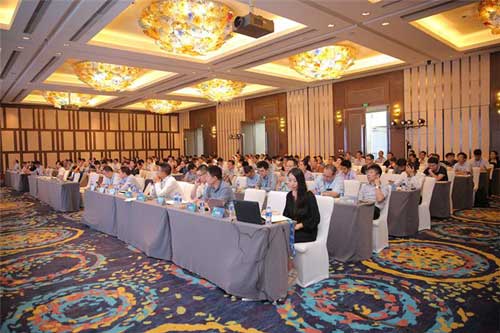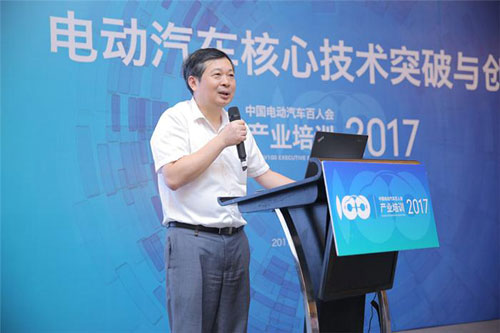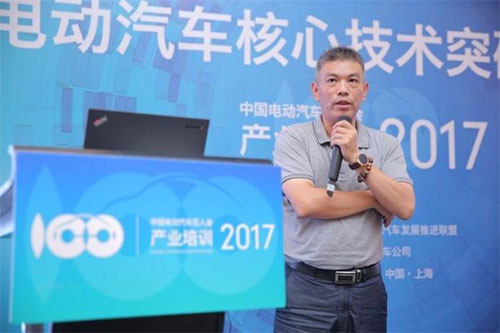On September 26–27, the "China Electric Vehicles 100 People" event organized a new industry training session in Shanghai Jiading Automobile City. The theme of this session was “Technology Breakthrough and Innovation of Electric Vehicles.†Experts from various fields, including Researcher and Doctoral Supervisor Huang Xuejie from the Institute of Physics, Chinese Academy of Sciences, and Professor Ai Xinping from Wuhan University’s School of Chemistry and Molecular Sciences, provided detailed insights into power battery technologies, key components, and future trends in battery development.

Industry leaders such as Zhou Peng from Huasheng (Hefei) Power Technology Co., Ltd., Zhang Zhouyun from Shanghai Electric Drive Co., Ltd., Yu Ping from Jingjin Electric Technology Co., Ltd., Zhu Yulong from Shanghai Jiexin Power Battery System Co., Ltd., Wang Ying, an expert in new energy vehicle power systems, and Song Zhihuan from Huayu Automotive Electric Systems Co., Ltd. shared their experiences on the development of electric drive systems and cutting-edge technologies.
As a core component of electric vehicles, power batteries directly influence the vehicle's speed and driving range. Therefore, continuous research into battery technology remains a top priority. The choice of materials significantly affects battery performance, and identifying the most suitable material for automotive use is a major challenge and focus within the industry.
Is lithium iron phosphate becoming obsolete?
Huang Xuejie, an expert involved in the “12th Five-Year Plan†National 863 Program for electric vehicles, has been researching lithium secondary batteries and related technologies. He explained that there are two main technical routes for power battery development in China. For commercial vehicles, lithium iron phosphate batteries are widely used due to their high energy density, with current specific energy exceeding 160 Wh/kg. Meanwhile, passenger cars favor ternary material batteries, which offer higher specific energy, reaching up to 220 Wh/kg for individual cells and 150 Wh/kg for battery packs.

Researcher and Doctoral Supervisor Huang Xuejie, Institute of Physics, Chinese Academy of Sciences
Despite these advancements, the specific energy still falls short of what consumers desire for longer driving ranges. As a result, researchers are continuously exploring different materials. Huang Xuejie noted that while lithium cobalt oxide is commonly used in mobile phones, other materials like lithium manganate, lithium iron phosphate, ternary materials, and high-nickel or lithium-rich compounds each have unique advantages.
NCA ternary materials, for example, are favored for their high specific energy and long storage life. SAFT of France uses them in satellites, and Tesla also employs NCA batteries. However, NCA has low cycle life and poor safety performance, making it less ideal for mass adoption in electric vehicles.
Huang Xuejie conducted a detailed comparison of these materials. While lithium cobaltate offers good performance, its high cost limits its use to consumer electronics. Lithium manganate is more cost-effective and is widely used in commercial vehicles, though its lower specific energy makes it unsuitable for high-performance applications. In contrast, lithium iron phosphate stands out for its long cycle life, strong safety, and decreasing costs, making it the current mainstream choice.
Ai Xinping shares a similar view. He has contributed to the Ministry of Science and Technology’s “New Energy Vehicle Steering†guide and strongly opposes increasing battery weight to boost driving range. He argues that this approach raises vehicle weight, increases energy consumption, and leads to higher costs, which is not sustainable for market growth.
Therefore, Ai Xinping emphasizes that the future of power battery development must focus on increasing specific energy while ensuring safety, longevity, and cycle life. He believes that lithium-ion batteries remain the primary direction for future development.
How can we increase the specific energy of lithium iron phosphate?
Huang Xuejie suggests that the focus should shift from improving the material itself to optimizing battery design and the anode material. He notes that lithium iron phosphate has already reached a mature production level, with annual output exceeding 100,000 tons. The next step is to pair it with the right anode material to enhance its performance.
He highlighted two promising materials: one allows fast charging at low temperatures, while the other offers higher specific energy. Graphene-based materials enable quick low-temperature charging, while silicon-carbon materials provide greater energy density, requiring nano-scale silicon to be effective.
Ai Xinping agrees that to improve the specific energy of lithium iron phosphate, challenges such as the low coulombic efficiency of silicon anodes and voltage decay in lithium-rich manganese-based materials must be addressed. He envisions advanced lithium-ion batteries with energy densities exceeding 400 Wh/kg. Looking ahead, he believes innovative lithium-ion batteries are more realistic than lithium-sulfur or solid-state batteries.

Professor Ai Xinping, Professor and Doctoral Supervisor, School of Chemistry and Molecular Sciences, Wuhan University
Ai Xinping emphasized that safety is crucial for high-energy battery applications. He advocates for the development of self-heating control technology and all-solid-state batteries as viable solutions. Additionally, he pointed out that high-capacity electrodes are essential for achieving high specific energy. According to polarization models, the development of gradient porosity electrodes plays a vital role in advancing high-energy battery technology.
The advantages of lithium iron phosphate are becoming increasingly evident.
According to Huang Xuejie, the specific energy of next-generation lithium iron phosphate batteries can reach 175 Wh/kg, meeting the needs of commercial vehicles that require 150 Wh/kg. He believes that continuing along this path could allow lithium iron phosphate battery packs to reach 180 Wh/kg by 2020, with significant room for further development. Moreover, lithium iron phosphate has a strong industrial foundation in China and holds potential for use in both commercial and energy storage applications.
In addition, Ai Xinping mentioned that solid-state batteries represent a future trend, but they require high anti-oxidation and low-temperature conductivity, which are not achievable with current ternary materials or lithium cobalt oxide. Only lithium iron phosphate can meet these requirements.
Fpc Membrane Switch,Fpc Membrane Switch With Metal Dome,Membrane Switch With Embossed Button,Membrane Switch With Metal Dome
CIXI MEMBRANE SWITCH FACTORY , https://www.cnjunma.com